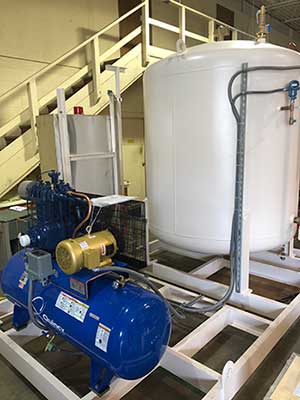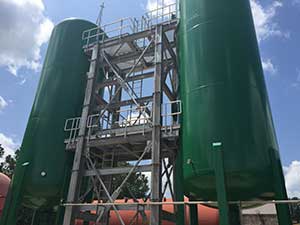Hydropneumatic Tanks
Function
The primary function of a hydropneumatic tank is to provide the required pumping cycle rate to avoid overheating of the pump motor and therefore pre-mature motor failure. It is not designed to provide the pressure requirements of the water system this is done by the high service pumps. Therefore the size of a hydropneumatic tank is governed by both the established pumping volume differential and the number of pumping cycles desired.
Experience indicates that the average number of pumping cycles need never be greater than ten and very seldom is it necessary to provide for fewer than six cycles per hour during normal usage. However the pumping cycle rate depends greatly on the horsepower and type of the pump motor.
Tank Size
The greater the number of pumping cycles the smaller will be the size of the required tank. This must be given serious consideration when the initial cost of the installation is of prime importance. Fewer cycles will require the use of a larger tank, however sometimes other considerations besides initial cost assume greater importance. Such as installations in or near hospitals, hotels sanitariums etc. where frequent pump starts & stops may be annoying.. Also where greater reserve is desired or required such as fire protection chlorine retention etc.
Efficiency
It must be remembered the maximum efficiency of a hydropneumatic tank is normally 25% of the total tank volume. The efficiency of the tank is determined by the maximum operating pressure and the pressure differential. The higher the pressure and the shorter the differential (from pump start to pump stop) the less efficient the tank becomes. The lower the pressure and the wider the pressure differential the more efficient the tank becomes.
Level Control
The optimum air to water ratio is 60% air and 40% water of total tank volume at the pump shut-off pressure. The minimum low water level should never be less than 10% of the tank volume over the tank outlet. The high water level is determined by the maximum pump cut-off pressure.
Cost Variables
Given the application requirements such as maximum and minimum water usage in gpm, and the operating pressure range we can determine the required hydropneumatic tank size in gallons and the pump or pumps size in gallons per minute along with an engineering cost estimate of the complete system including all components and services.
Surge Tanks
Function
The primary function of a hydropneumatic surge tank is to provide mitigation of surge events in a piping system due to pump starts, pump stops and the most critical pump trip. When a pump starts, stops or suddenly trips, result is a pulse wave that is transmitted down the piping system at 1800 feet per second. This wave reflects off of pipe transitions, fittings, changes in direction, closed valves or ends of pipes.
Surge Pressure
When this happens, the wave is propagated back along the piping system which when the piping system has changes in elevations causing high pressures at the top of the wave as the water travels from a higher elevation to a lower elevation, and low pressures at the bottom of the wave as the water travels from a lower elevation to a higher elevation.
The high pressures can cause damage to the piping system or components that are not rated for the high pressures caused by the surge The low pressures can be pulled into a vacuum or cavitation which will cause the piping system to fail by opening flange connections and allowing ground water to enter and contaminate the piping system.
Solution
The hydropneumatic surge tank has an air to water ratio calculated by a surge analysis, to mitigate the surge event. This is accomplished to reduce the high pressures by having the air in the surge tank compress to absorb the pressure of the water damping the push of the water in the piping system. The low pressures are mitigated by allowing water from the surge tank to flow out into the piping system, keeping the system pressure from dropping down into the vacuum / cavitation levels. As the surge event propagates from the high and low pressure waves, each wave will reduce in a very signification level to quickly dampen and stop the surge.

 The primary function of a hydropneumatic tank is to provide the required pumping cycle rate to avoid overheating of the pump motor and therefore pre-mature motor failure. It is not designed to provide the pressure requirements of the water system this is done by the high service pumps. Therefore the size of a hydropneumatic tank is governed by both the established pumping volume differential and the number of pumping cycles desired.
The primary function of a hydropneumatic tank is to provide the required pumping cycle rate to avoid overheating of the pump motor and therefore pre-mature motor failure. It is not designed to provide the pressure requirements of the water system this is done by the high service pumps. Therefore the size of a hydropneumatic tank is governed by both the established pumping volume differential and the number of pumping cycles desired. When this happens, the wave is propagated back along the piping system which when the piping system has changes in elevations causing high pressures at the top of the wave as the water travels from a higher elevation to a lower elevation, and low pressures at the bottom of the wave as the water travels from a lower elevation to a higher elevation.
When this happens, the wave is propagated back along the piping system which when the piping system has changes in elevations causing high pressures at the top of the wave as the water travels from a higher elevation to a lower elevation, and low pressures at the bottom of the wave as the water travels from a lower elevation to a higher elevation.
